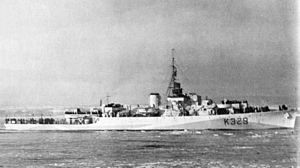HMCS Valleyfield (K329)

HMCS Valleyfield
|
|
| History | |
|---|---|
|
|
|
| Name: | Valleyfield |
| Namesake: | Salaberry-de-Valleyfield, Quebec |
| Ordered: | October 1941 |
| Builder: | Morton Engineering and Dry Dock Co., Quebec City |
| Laid down: | 30 November 1942 |
| Launched: | 17 July 1943 |
| Commissioned: | 7 December 1943 |
| Out of service: | 7 May 1944 |
| Identification: | pennant number:K 329 |
| Honours and awards: |
Atlantic 1944 |
| Fate: | Torpedoed and sunk on 7 May 1944. |
| General characteristics | |
| Class and type: | River-class frigate |
| Displacement: |
|
| Length: | |
| Beam: | 36.5 ft (11.13 m) |
| Draught: | 9 ft (2.74 m); 13 ft (3.96 m) (deep load) |
| Propulsion: | 2 x Admiralty 3-drum boilers, 2 shafts, reciprocating vertical triple expansion, 5,500 ihp (4,100 kW) |
| Speed: |
|
| Range: | 646 long tons (656 t; 724 short tons) oil fuel; 7,500 nautical miles (13,890 km) at 15 knots (27.8 km/h) |
| Complement: | 157 |
| Armament: |
|
HMCS Valleyfield was a River-class frigate that served with the Royal Canadian Navy during the Second World War. She served primarily as a convoy escort in the Battle of the Atlantic. She was torpedoed and sunk in May 1944, the only River-class frigate lost by the RCN. She was named for Salaberry-de-Valleyfield, Quebec.
Valleyfield was ordered in October 1941 as part of the 1942–1943 River-class building program. She was laid down on 30 November 1942 by Morton Engineering and Dry Dock Co. at Quebec City and launched 17 July 1943. She was commissioned into the RCN on 7 December 1943 at Quebec City.
The River-class frigate was designed by William Reed of Smith's Dock Company of South Bank-on-Tees. Originally called a "twin-screw corvette", its purpose was to improve on the convoy escort classes in service with the Royal Navy at the time, including the Flower-class corvette. The first orders were placed by the Royal Navy in 1940 and the vessels were named for rivers in the United Kingdom, giving name to the class. In Canada they were named for towns and cities though they kept the same designation. The name "frigate" was suggested by Vice-Admiral Percy Nelles of the Royal Canadian Navy and was adopted later that year.
Improvements over the corvette design included improved accommodation which was markedly better. The twin engines gave only three more knots of speed but extended the range of the ship to nearly double that of a corvette at 7,200 nautical miles (13,300 km) at 12 knots. Among other lessons applied to the design was an armament package better designed to combat U-boats including a twin 4-inch mount forward and 12-pounder aft. 15 Canadian frigates were initially fitted with a single 4-inch gun forward but with the exception of Valleyfield, they were all eventually upgraded to the double mount. For underwater targets, the River-class frigate was equipped with a Hedgehog anti-submarine mortar and depth charge rails aft and four side-mounted throwers.
...
Wikipedia
